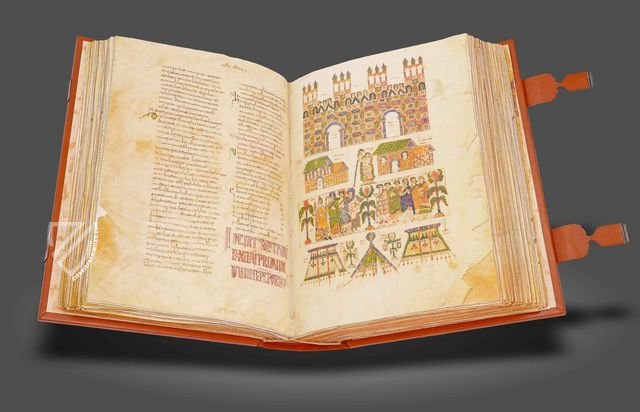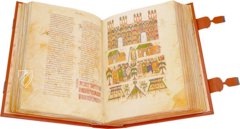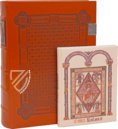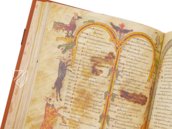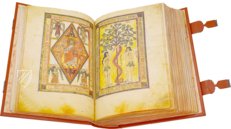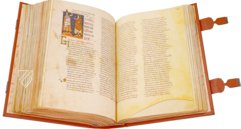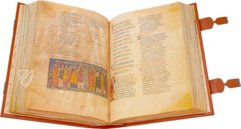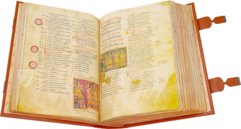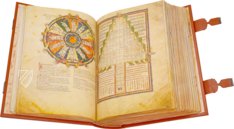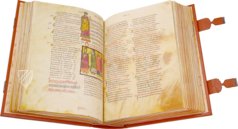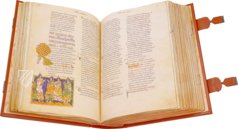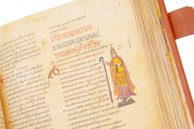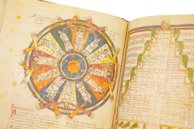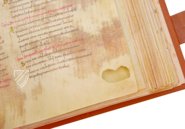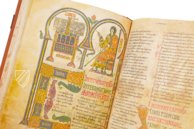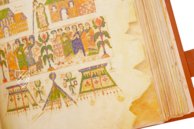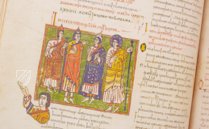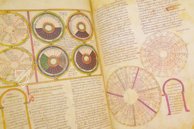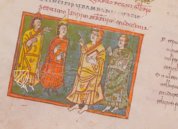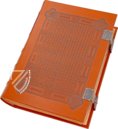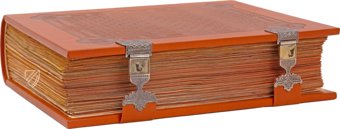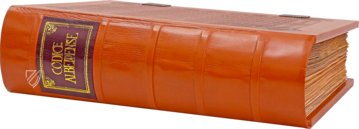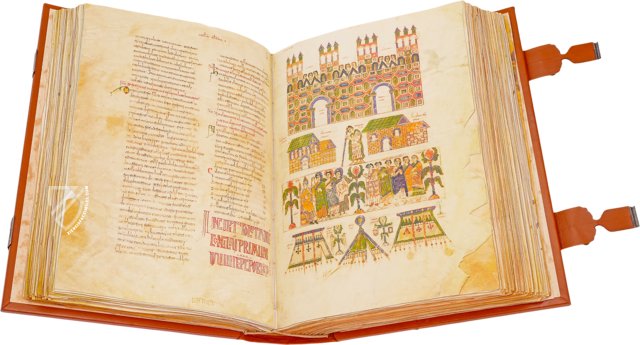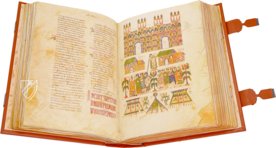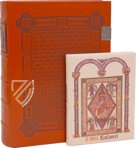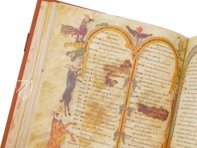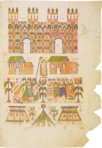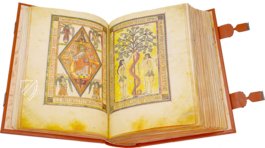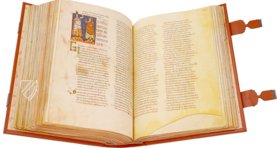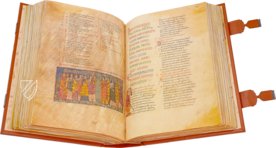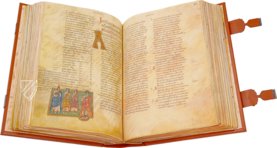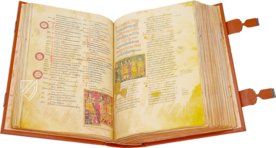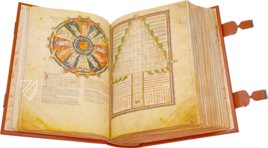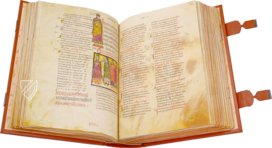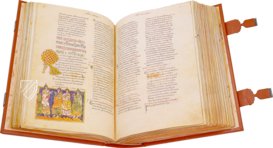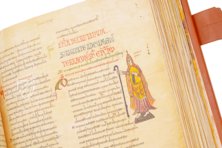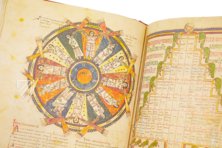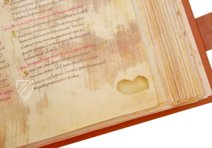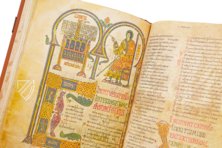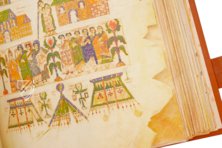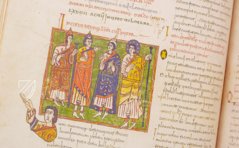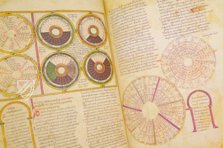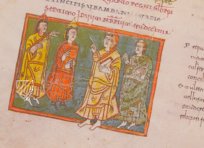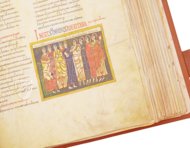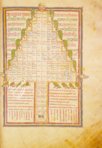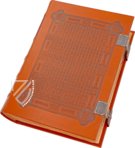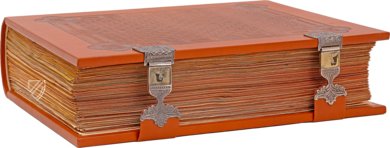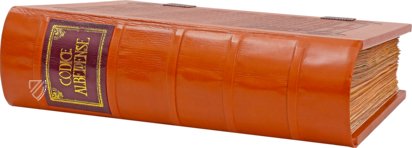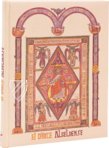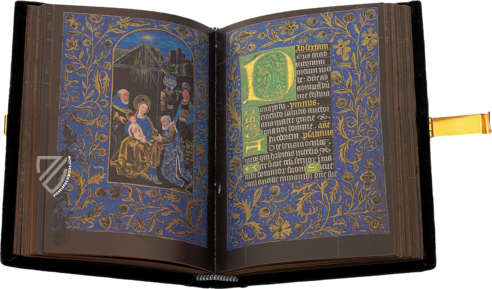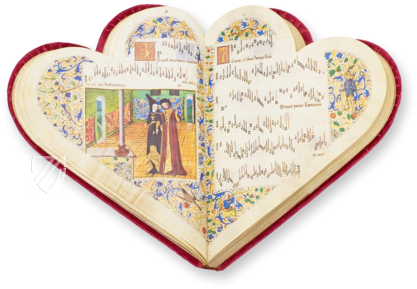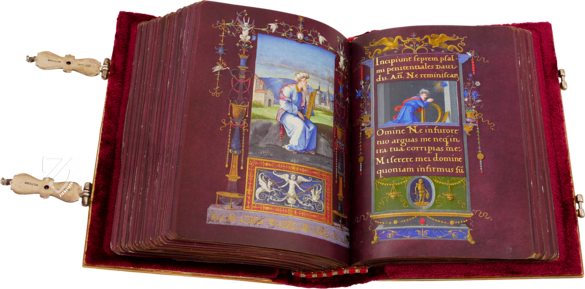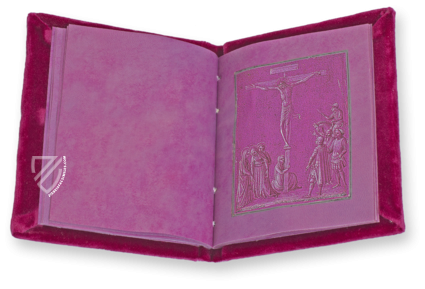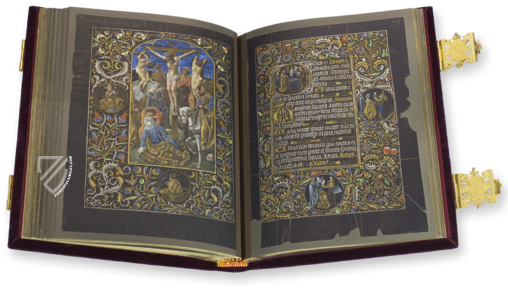Codex Albeldense
(7,000€ - 10,000€)
The Codex Albeldense, stored in the famous collection of the El Escorial, is counted among the most important historical Spanish sources from the 10th century. Made in the Monastery of San Martín de Albelda, lying in the region of Rioja, the codex contains a comprehensive chronicle of the Kingdom of Asturias under King Alfosno III. This chronicle, composed at the Asturian royal court at the end of the 9th century, is an inestimably valuable source of knowledge about the Visigothic, Asturian, and Galician kingdoms. In the gorgeous Codex Albeldense, one of four surviving specimens of the chronicle, these informative explanations illustrate cityscapes, portraits of important historical figures, and an additional 82 miniatures in the most wonderful way. A marvelous testimony to Spanish history!
Codex Albeldense
The Codex Albeldense, stored in the famous collection of the El Escorial, is counted among the most important historical Spanish sources from the 10th century. Created in the Monastery of San Martín de Albelda in the region of Rioja, the miscellany contains various legal texts and a Christian vita of the Prophet Muhammad, as well as a comprehensive chronicle of the Kingdom of Asturias under King Alfosno III. This chronicle, composed at the Asturian royal court at the end of the 9th century, is an inestimably valuable source of knowledge about the Visigothic, Asturian, and Galician kingdoms. In the gorgeous Codex Albeldense, one of four surviving specimens of the chronicle, these informative explanations illustrate cityscapes, portraits of important historical figures, and an additional 82 miniatures in the most wonderful way. A marvelous testimony to Spanish history!
The Codex Vigilianus
The scribe and miniaturist Viglia was responsible to the splendid décor of the codex. Along with his assistants Sarracino and García, he visually immortalized himself in one of the gorgeous miniatures. The codex from Albelda is also known as the Codex Vigilianus, after this Viglia, who copied the chronicle from older specimens and carried it forward with lists of kings up to the year 976. The illuminator adorned the manuscript with 82 miniatures altogether, some of them even full-paged. One finds informative tables, lists, and gorgeous initials here alongside marvelous cityscapes, e.g. of Toledo, and full-figured portraits. The paintings obviously have a strong Carolingian influence stylistically, and appear nonetheless to be extremely ornamental, e.g. with extremely complicated interlacing ornamentation. Viglia and his colleagues were certainly among the most outstanding masters in the Monastery of San Martín de Albelda with its famous scriptorium!
An Asturian Chronicle
The content of the Codex Albeldense was based on a famous chronicle, which was composed at the royal court of King Alfonso III (866–910). The author was probably a cleric from the circle of Oviedo or Leon. This chronicle relates the history and geography of the world in a quick summary – from Adam to the Romans to the Visigoths. Thereafter follows detailed information about the Iberian Peninsula and the history of the Asturian Kingdom as the successor to the Visigothic Kingdom up to the time of King Alfonso III. The first version of the chronicle closes with the year 881, giving an indication of its time of creation. The chronicle survives today in four codices, the famous Codex Albeldense is counted as the oldest among them.
The Vita of Muhammad between canonical and civil legal texts
The miscellany also includes a remarkable calendar with Arabic numbers, making it the oldest surviving European document in which these were used. The codex also contains the Vida de Mahoma, a description of the life of the Prophet Mohammed, which was written from a Christian perspective. The numerous legal texts collected in the manuscript are also invaluable and represent a valuable source of knowledge about the early medieval society on the Iberian Peninsula. These include canonical legal texts such as council acts and a selection of canones and decretals of the early popes up to Gregory the Great, but also an important collection of laws on civil jurisdiction in the Visigothic Empire, which was valid from late antiquity to modern times.
Outstanding Significance for Spain
The Codex Albeldense came into the possession of King Philip II of Spain in the 16th century as a gift from the Count of Buendía. He in turn incorporated the outstanding treasure into the famous library of his royal monastery of El Escorial. In spite of some corruption of historical facts, the Codex Albeldense has outstanding significance as an invaluable source of knowledge both historically and artistically. It is considered to be a historic source for the history of the Visigothic, Asturian, and Galician Kingdoms of Spain. With its legal codes, lists of council decisions, a calendar, in which the Arabic numerals first appear in a European document, and the Vide de Mahoma – a description of the life of Moghammad from a Christian perspective – this significance is unquestionable!
Codicology
- Alternative Titles
- Albeldense Codex
Códice Albeldense
Vigilian
Crónica Albeldense
Codex conciliorum Albeldensis seu Vigilanus
Codice Albeldense seu Vigilanus
Albelda Codex - Size / Format
- 858 pages / 45.5 × 32.5 cm
- Origin
- Spain
- Date
- 976
- Epochs
- Style
- Language
- Illustrations
- 82 miniatures, some of them covering a whole folio
- Content
- Collectio Hispana, Council of Toledo, Isidore, Etymologiae and De fide catholica contra Iudaeos, Mozarabic calendar, history of Muhammad, names of famous men, Vita Salvi abbatis Albaildensis, homilies of Gregory the Great, excerpts from the Rule of Benedi
- Patron
- Count of Buendía
- Artist / School
- Vigila (scribe)
Sarracino (illuminator)
García (illuminator) - Previous Owners
- Philip II, King of Spain and Portugal (reigned 1556–1598)
#1 Códice Albeldense
Language: Spanish
(7,000€ - 10,000€)
- Treatises / Secular Books
- Apocalypses / Beatus
- Astronomy / Astrology
- Bestiaries
- Bibles / Gospels
- Chronicles / History / Law
- Geography / Maps
- Saints' Lives
- Islam / Oriental
- Judaism / Hebrew
- Single Leaf Collections
- Leonardo da Vinci
- Literature / Poetry
- Liturgical Manuscripts
- Medicine / Botany / Alchemy
- Music
- Mythology / Prophecies
- Psalters
- Other Religious Books
- Games / Hunting
- Private Devotion Books
- Other Genres
- Afghanistan
- Armenia
- Austria
- Belgium
- Belize
- Bosnia and Herzegovina
- China
- Colombia
- Costa Rica
- Croatia
- Cyprus
- Czech Republic
- Denmark
- Egypt
- El Salvador
- Ethiopia
- France
- Germany
- Greece
- Guatemala
- Honduras
- Hungary
- India
- Iran
- Iraq
- Israel
- Italy
- Japan
- Jordan
- Kazakhstan
- Kyrgyzstan
- Lebanon
- Liechtenstein
- Luxembourg
- Mexico
- Morocco
- Netherlands
- Palestine
- Panama
- Peru
- Poland
- Portugal
- Romania
- Russia
- Serbia
- Spain
- Sri Lanka
- Sweden
- Switzerland
- Syria
- Tajikistan
- Turkey
- Turkmenistan
- Ukraine
- United Kingdom
- United States
- Uzbekistan
- Vatican City
- A. Oosthoek, van Holkema & Warendorf
- Aboca Museum
- Ajuntament de Valencia
- Akademie Verlag
- Akademische Druck- u. Verlagsanstalt (ADEVA)
- Aldo Ausilio Editore - Bottega d’Erasmo
- Alecto Historical Editions
- Alkuin Verlag
- Almqvist & Wiksell
- Amilcare Pizzi
- Andreas & Andreas Verlagsbuchhandlung
- Archa 90
- Archiv Verlag
- Archivi Edizioni
- Arnold Verlag
- ARS
- Ars Magna
- ArtCodex
- AyN Ediciones
- Azimuth Editions
- Badenia Verlag
- Bärenreiter-Verlag
- Belser Verlag
- Belser Verlag / WK Wertkontor
- Benziger Verlag
- Bernardinum Wydawnictwo
- BiblioGemma
- Biblioteca Apostolica Vaticana (Vaticanstadt, Vaticanstadt)
- Bibliotheca Palatina Faksimile Verlag
- Bibliotheca Rara
- Boydell & Brewer
- Bramante Edizioni
- Bredius Genootschap
- Brepols Publishers
- British Library
- C. Weckesser
- Caixa Catalunya
- Canesi
- CAPSA, Ars Scriptoria
- Caratzas Brothers, Publishers
- Carus Verlag
- Casamassima Libri
- Centrum Cartographie Verlag GmbH
- Chavane Verlag
- Christian Brandstätter Verlag
- Circulo Cientifico
- Club Bibliófilo Versol
- Club du Livre
- CM Editores
- Collegium Graphicum
- Collezione Apocrifa Da Vinci
- Comissão Nacional para as Comemorações dos Descobrimentos Portugueses
- Coron Verlag
- Corvina
- CTHS
- D. S. Brewer
- Damon
- De Agostini/UTET
- De Nederlandsche Boekhandel
- De Schutter
- Deuschle & Stemmle
- Deutscher Verlag für Kunstwissenschaft
- DIAMM
- Droz
- E. Schreiber Graphische Kunstanstalten
- Ediciones Boreal
- Ediciones Grial
- Ediclube
- Edições Inapa
- Edilan
- Editalia
- Edition Deuschle
- Edition Georg Popp
- Edition Leipzig
- Edition Libri Illustri
- Editiones Reales Sitios S. L.
- Éditions de l'Oiseau Lyre
- Editions Medicina Rara
- Editorial Casariego
- Editorial Mintzoa
- Editrice Antenore
- Editrice Velar
- Edizioni Edison
- Egeria, S.L.
- Eikon Editores
- Electa
- Emery Walker Limited
- Enciclopèdia Catalana
- Eos-Verlag
- Ephesus Publishing
- Ernst Battenberg
- Eugrammia Press
- Extraordinary Editions
- Fackelverlag
- Facsimila Art & Edition
- Facsimile Editions Ltd.
- Facsimilia Art & Edition Ebert KG
- Faksimile Verlag
- Feuermann Verlag
- Folger Shakespeare Library
- Franco Cosimo Panini Editore
- Friedrich Wittig Verlag
- Fundación Hullera Vasco-Leonesa
- G. Braziller
- Gabriele Mazzotta Editore
- Gebr. Mann Verlag
- Gesellschaft für graphische Industrie
- Getty Research Institute
- Giovanni Domenico de Rossi
- Giunti Editore
- Graffiti
- Grafica European Center of Fine Arts
- Guido Pressler
- Guillermo Blazquez
- Gustav Kiepenheuer
- H. N. Abrams
- Harrassowitz
- Harvard University Press
- Helikon
- Hendrickson Publishers
- Henning Oppermann
- Herder Verlag
- Hes & De Graaf Publishers
- Hoepli
- Holbein-Verlag
- Houghton Library
- Hugo Schmidt Verlag
- Idion Verlag
- Il Bulino, edizioni d'arte
- ILte
- Imago
- Insel Verlag
- Insel-Verlag Anton Kippenberger
- Instituto de Estudios Altoaragoneses
- Instituto Nacional de Antropología e Historia
- Istituto dell'Enciclopedia Italiana - Treccani
- Istituto Ellenico di Studi Bizantini e Postbizantini
- Istituto Geografico De Agostini
- Istituto Poligrafico e Zecca dello Stato
- Italarte Art Establishments
- Jan Thorbecke Verlag
- Johnson Reprint Corporation
- Josef Stocker
- Josef Stocker-Schmid
- Jugoslavija
- Karl W. Hiersemann
- Kasper Straube
- Kaydeda Ediciones
- Kindler Verlag / Coron Verlag
- Kodansha International Ltd.
- Konrad Kölbl Verlag
- Kurt Wolff Verlag
- La Liberia dello Stato
- La Linea Editrice
- La Meta Editore
- Lambert Schneider
- Landeskreditbank Baden-Württemberg
- Leo S. Olschki
- Les Incunables
- Liber Artis
- Library of Congress
- Libreria Musicale Italiana
- Lichtdruck
- Lito Immagine Editore
- Lumen Artis
- Lund Humphries
- M. Moleiro Editor
- Maison des Sciences de l'homme et de la société de Poitiers
- Manuscriptum
- Martinus Nijhoff
- Maruzen-Yushodo Co. Ltd.
- MASA
- Massada Publishers
- McGraw-Hill
- Metropolitan Museum of Art
- Militos
- Millennium Liber
- Müller & Schindler
- Nahar - Stavit
- Nahar and Steimatzky
- National Library of Wales
- Neri Pozza
- Nova Charta
- Oceanum Verlag
- Odeon
- Orbis Mediaevalis
- Orbis Pictus
- Österreichische Staatsdruckerei
- Oxford University Press
- Pageant Books
- Parzellers Buchverlag
- Patrimonio Ediciones
- Pattloch Verlag
- PIAF
- Pieper Verlag
- Plon-Nourrit et cie
- Poligrafiche Bolis
- Presses Universitaires de Strasbourg
- Prestel Verlag
- Princeton University Press
- Prisma Verlag
- Priuli & Verlucca, editori
- Pro Sport Verlag
- Propyläen Verlag
- Pytheas Books
- Quaternio Verlag Luzern
- Reales Sitios
- Recht-Verlag
- Reichert Verlag
- Reichsdruckerei
- Reprint Verlag
- Riehn & Reusch
- Roberto Vattori Editore
- Rosenkilde and Bagger
- Roxburghe Club
- Salerno Editrice
- Saltellus Press
- Sandoz
- Sarajevo Svjetlost
- Schöck ArtPrint Kft.
- Schulsinger Brothers
- Scolar Press
- Scrinium
- Scripta Maneant
- Scriptorium
- Shazar
- Siloé, arte y bibliofilia
- SISMEL - Edizioni del Galluzzo
- Sociedad Mexicana de Antropología
- Société des Bibliophiles & Iconophiles de Belgique
- Soncin Publishing
- Sorli Ediciones
- Stainer and Bell
- Studer
- Styria Verlag
- Sumptibus Pragopress
- Szegedi Tudomànyegyetem
- Taberna Libraria
- Tarshish Books
- Taschen
- Tempus Libri
- Testimonio Compañía Editorial
- Thames and Hudson
- The Clear Vue Publishing Partnership Limited
- The Facsimile Codex
- The Folio Society
- The Marquess of Normanby
- The Richard III and Yorkist History Trust
- Tip.Le.Co
- TouchArt
- TREC Publishing House
- TRI Publishing Co.
- Trident Editore
- Tuliba Collection
- Typis Regiae Officinae Polygraphicae
- Union Verlag Berlin
- Universidad de Granada
- University of California Press
- University of Chicago Press
- Urs Graf
- Vallecchi
- Van Wijnen
- VCH, Acta Humaniora
- VDI Verlag
- VEB Deutscher Verlag für Musik
- Verlag Anton Pustet / Andreas Verlag
- Verlag Bibliophile Drucke Josef Stocker
- Verlag der Münchner Drucke
- Verlag für Regionalgeschichte
- Verlag Styria
- Vicent Garcia Editores
- W. Turnowski Ltd.
- W. Turnowsky
- Waanders Printers
- Wiener Mechitharisten-Congregation (Wien, Österreich)
- Wissenschaftliche Buchgesellschaft
- Wissenschaftliche Verlagsgesellschaft
- Wydawnictwo Dolnoslaskie
- Xuntanza Editorial
- Zakład Narodowy
- Zollikofer AG

